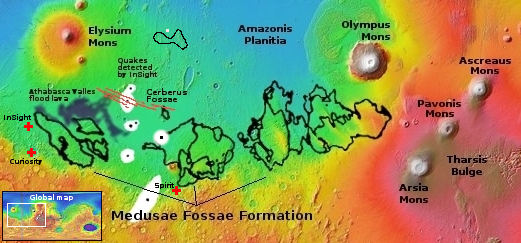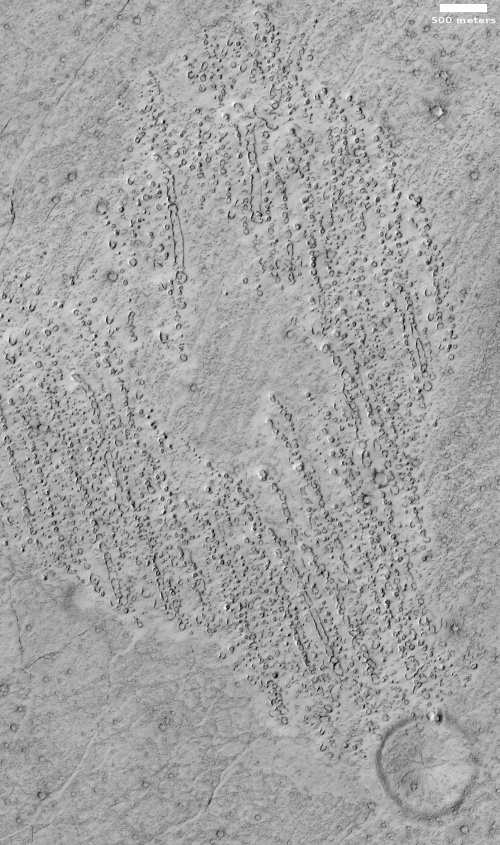A Martian crater with a wake of lava

Cool image time! Today’s cool image begins with the overview map to the right. The white dot marks its location, on the western edge of Amazonis Planitia and about 1,000 miles east of the giant shield volcano Elysium Mons.
This is a region of numerous flood lava events that appear to cover the knobby mountainous terrain that was once here. We know that past terrain was knobby because in the black outline just south of this picture the knobs are everywhere, short peaks sticking up from a very flat flood lava plain. The region is also on the northern edge of the dry equatorial regions of Mars, at 27 degrees north latitude. It is likely there is little near surface ice here.
These details will help explain the cool image itself.
The picture to the right, rotated, cropped, and reduced to post here, was taken on April 22, 2023 by the high resolution camera on Mars Reconnaissance Orbiter (MRO).
The camera team titles this picture “lines of cratered cones.” That description however doesn’t capture the wakelike shape of those lines, all to the northwest of that 3,300 foot wide crater, which itself appears almost entirely filled with lava.
How can we explain this pattern of cones? I will make a guess, but I guarantee I am almost certainly wrong, and even if I am right my theory will only provide a very partial explanation. Let’s say the flood lava was flowing from the southeast to the northwest. As it hit this crater, it was forced to flow around it, creating an eddy to the northwest of the crater so that less lava was available to cover the cones and knobs that were already there.
Sounds great, eh? It works to a degree, since the edges of this wake are slightly lower in elevation. However its central area is actually higher, which means the shape of the wake likely existed before the flood lava arrived. Moreover, all I am attempting to do is explain why these cones were not covered by lava. I have no idea what formed them, or why they are lined up in this manner.
It is also possible that some process involving underground ice is involved, since only a few hundred miles north of this location we begin to find a lot of glacial evidence. At some point in the past, when Mars’ rotational tilt was different, this spot might have harbored ice near the surface, which could have played a factor in shaping it.
Some volcanic/lava flow process was likely involved, with the possible interaction with ice, but I don’t know enough about those processes to even hazard a guess. I also suspect the planetary scientists who are studying this spot don’t know themselves with any clarity, which is why they are studying it.
One last guess that came to mind just before I posted. What if the crater is not from impact, but was a caldera vent, and the cones indicate the lava flow from that vent?
Isn’t speculation fun? I admire the scientists who dig into the facts to put aside such wild theories to find out what actually happened.
On Christmas Eve 1968 three Americans became the first humans to visit another world. What they did to celebrate was unexpected and profound, and will be remembered throughout all human history. Genesis: the Story of Apollo 8, Robert Zimmerman's classic history of humanity's first journey to another world, tells that story, and it is now available as both an ebook and an audiobook, both with a foreword by Valerie Anders and a new introduction by Robert Zimmerman.
The print edition can be purchased at Amazon or from any other book seller. If you want an autographed copy the price is $60 for the hardback and $45 for the paperback, plus $8 shipping for each. Go here for purchasing details. The ebook is available everywhere for $5.99 (before discount) at amazon, or direct from my ebook publisher, ebookit. If you buy it from ebookit you don't support the big tech companies and the author gets a bigger cut much sooner.
The audiobook is also available at all these vendors, and is also free with a 30-day trial membership to Audible.
"Not simply about one mission, [Genesis] is also the history of America's quest for the moon... Zimmerman has done a masterful job of tying disparate events together into a solid account of one of America's greatest human triumphs."--San Antonio Express-News

Cool image time! Today’s cool image begins with the overview map to the right. The white dot marks its location, on the western edge of Amazonis Planitia and about 1,000 miles east of the giant shield volcano Elysium Mons.
This is a region of numerous flood lava events that appear to cover the knobby mountainous terrain that was once here. We know that past terrain was knobby because in the black outline just south of this picture the knobs are everywhere, short peaks sticking up from a very flat flood lava plain. The region is also on the northern edge of the dry equatorial regions of Mars, at 27 degrees north latitude. It is likely there is little near surface ice here.
These details will help explain the cool image itself.
The picture to the right, rotated, cropped, and reduced to post here, was taken on April 22, 2023 by the high resolution camera on Mars Reconnaissance Orbiter (MRO).
The camera team titles this picture “lines of cratered cones.” That description however doesn’t capture the wakelike shape of those lines, all to the northwest of that 3,300 foot wide crater, which itself appears almost entirely filled with lava.
How can we explain this pattern of cones? I will make a guess, but I guarantee I am almost certainly wrong, and even if I am right my theory will only provide a very partial explanation. Let’s say the flood lava was flowing from the southeast to the northwest. As it hit this crater, it was forced to flow around it, creating an eddy to the northwest of the crater so that less lava was available to cover the cones and knobs that were already there.
Sounds great, eh? It works to a degree, since the edges of this wake are slightly lower in elevation. However its central area is actually higher, which means the shape of the wake likely existed before the flood lava arrived. Moreover, all I am attempting to do is explain why these cones were not covered by lava. I have no idea what formed them, or why they are lined up in this manner.
It is also possible that some process involving underground ice is involved, since only a few hundred miles north of this location we begin to find a lot of glacial evidence. At some point in the past, when Mars’ rotational tilt was different, this spot might have harbored ice near the surface, which could have played a factor in shaping it.
Some volcanic/lava flow process was likely involved, with the possible interaction with ice, but I don’t know enough about those processes to even hazard a guess. I also suspect the planetary scientists who are studying this spot don’t know themselves with any clarity, which is why they are studying it.
One last guess that came to mind just before I posted. What if the crater is not from impact, but was a caldera vent, and the cones indicate the lava flow from that vent?
Isn’t speculation fun? I admire the scientists who dig into the facts to put aside such wild theories to find out what actually happened.
On Christmas Eve 1968 three Americans became the first humans to visit another world. What they did to celebrate was unexpected and profound, and will be remembered throughout all human history. Genesis: the Story of Apollo 8, Robert Zimmerman's classic history of humanity's first journey to another world, tells that story, and it is now available as both an ebook and an audiobook, both with a foreword by Valerie Anders and a new introduction by Robert Zimmerman.
The print edition can be purchased at Amazon or from any other book seller. If you want an autographed copy the price is $60 for the hardback and $45 for the paperback, plus $8 shipping for each. Go here for purchasing details. The ebook is available everywhere for $5.99 (before discount) at amazon, or direct from my ebook publisher, ebookit. If you buy it from ebookit you don't support the big tech companies and the author gets a bigger cut much sooner.
The audiobook is also available at all these vendors, and is also free with a 30-day trial membership to Audible.
"Not simply about one mission, [Genesis] is also the history of America's quest for the moon... Zimmerman has done a masterful job of tying disparate events together into a solid account of one of America's greatest human triumphs."--San Antonio Express-News


